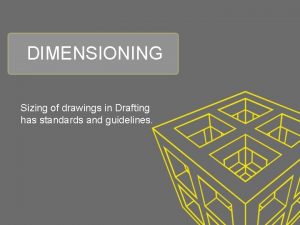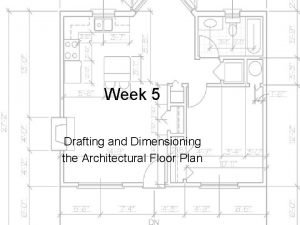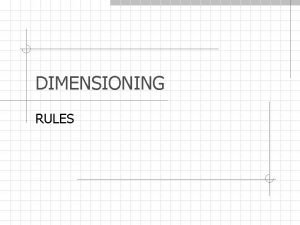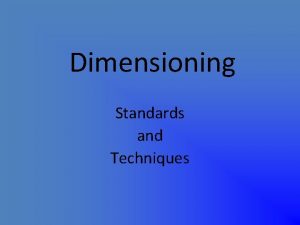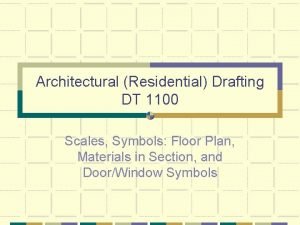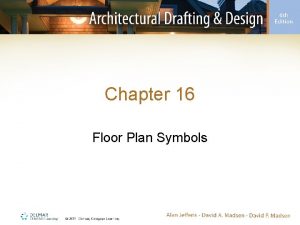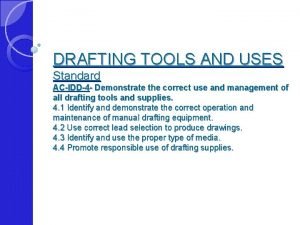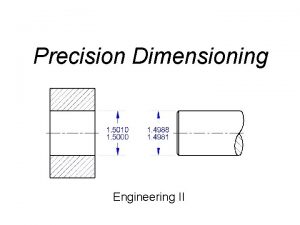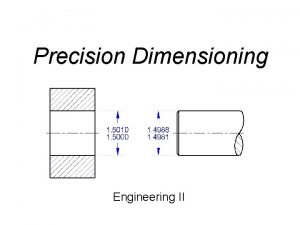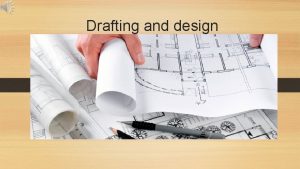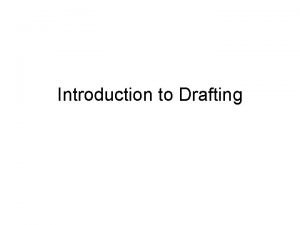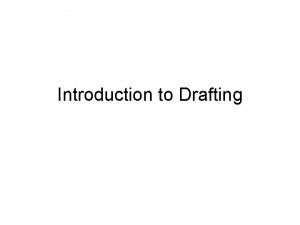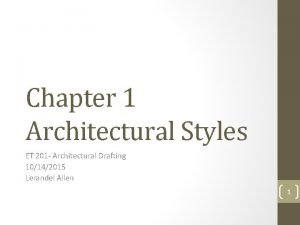Week 5 Drafting and Dimensioning the Architectural Floor





















- Slides: 21

Week 5 Drafting and Dimensioning the Architectural Floor Plan

Objectives • This chapter discusses how to draft and dimension a floor plan using straight-edged tools • The single-family residence is the primary focus

What is a Floor Plan? • Orthographic, two-dimensional drawing made by inserting a horizontal cutting plane 4'-0" above the ground • Shows lengths and widths, but not heights • The roof and walls above the cutting plane are “lifted up” • Cutting plane may be staggered at different levels – Example: split-level houses

What is a Floor Plan? (cont’d. ) Figure 8 -1 A floor plan is made with a horizontal cutting plane 4' -0" above the ground.

What Goes on in an Architectural Floor Plan? • Shows finished and unfinished space – Balconies, attached garages, decks, patios, and pools – Walls, wall openings, windows, door swings, skylights, exposed beams, etc. • Room names and symbols that reference the plan to schedules, sections, and details • Each level of the building has its own plan

What Goes on in an Architectural Floor Plan? (cont’d. ) Figure 8 -6 Construction drawing of a house floor plan.

Symbols • Knowledge of symbols, poché, and wall thickness is needed to draw a floor plan • Items must be pochéd with line symbols that represent the material they are made of • Walls must be drawn with a thickness that represents their construction • Doors, windows, cabinets, drains, draperies, and other common items are drawn to represent their size and type

Symbols (cont’d. ) Figure 8 -7 Different ways to poche a 6" exterior wood-frame wall.

Drafting a Floor Plan • Decide which scale to use • Draw the plan’s overall width and length • Draw the exterior walls, the interior walls, door and window openings, the stairs and fireplace

Drafting a Floor Plan (cont’d. ) • Darken the walls • Draw cabinetry, appliances, plumbing fixtures, and door and window symbols, and outline the front and back porches • Draw a second-floor plan

Drafting a Floor Plan (cont’d. ) Figure 8 -25 If a furniture plan is needed, add furniture

Types of Walls • • • Load-bearing walls can be interior/exterior Non–load-bearing walls bear no weight Partial walls are not full height Partitions are non-load bearing interior walls Chase is a passage between floors or walls Dimensions are numbers that describe the size of features and their location from other features

Types of Walls (cont’d. ) Figure 8 -31 Chase wall thickness for floor and wallmounted fixtures

Dimensioning Architectural Construction Plans • Essential rules for dimensioning are accuracy, completeness, and a single, legible interpretation • Architectural dimensioning is aligned • Imperial dimension notes in feet and inches • Circles and arcs are dimensioned from their center points

Dimensioning Architectural Construction Plans (cont’d. ) • Typically three stringers • Place exterior dimensions outside the plan to avoid overcrowding • Varies depending on whether building is standard, wood frame, or masonry • Doors and windows must be located on the drawings

Dimensioning Architectural Construction Plans (cont’d. ) Figure 8 -35 Locate a circle’s or curve’s center from two directions.

Dimensioning Architectural Construction Plans (cont’d. ) Figure 8 -34 Place a dimension note outside a space if there is not enough room to place it inside

Dimensioning Architectural Construction Plans (cont’d. ) Figure 8 -39 Dimensioning practices for wood, masonry, and veneer construction

Dimensioning Cabinet Industry Plans • • Drawings are done to a 12" 1'-0" scale Wall cabinets are drawn with a solid line Appliances are dimensioned to their centers Special features such as pull-out shelves and lazy Susans are not drawn • All numbers are given in inches or inches and fractions of inches • Height is from finished floor to ceiling

Dimensioning Cabinet Industry Plans (cont’d. ) Figure 8 -42 Bathroom dimensioned to cabinet industry standards. Note that fixtures are dimensioned to their centers. Circled numbers reference millwork to a schedule.

Summary • Floor plans are hard-lined once the layout is final • Fixed architectural features are shown in symbol form • Other symbols reference the plan to other drawings • Dimension notes show the size and location of the features • Dimensioning is done differently depending on the target audience for the drawing
 Superimposed dimensioning
Superimposed dimensioning Dimensioned floor plan
Dimensioned floor plan Dimensiona0
Dimensiona0 Architectural dimensioning rules
Architectural dimensioning rules Scale symbol architecture
Scale symbol architecture Floor plans symbols
Floor plans symbols Week by week plans for documenting children's development
Week by week plans for documenting children's development Geometric dimensioning and tolerancing
Geometric dimensioning and tolerancing Example of analysis paragraph
Example of analysis paragraph 10 drafting tools
10 drafting tools Drafting symbols
Drafting symbols Planning drafting revising editing
Planning drafting revising editing Exercise on noting and drafting
Exercise on noting and drafting Inspire drafting and design
Inspire drafting and design Call and return architecture example
Call and return architecture example Conceptual view of iot
Conceptual view of iot Architectural styles and patterns
Architectural styles and patterns Internetworking concepts and architectural model
Internetworking concepts and architectural model Architectural model of distributed system
Architectural model of distributed system Architectural tactics and patterns
Architectural tactics and patterns Hình ảnh bộ gõ cơ thể búng tay
Hình ảnh bộ gõ cơ thể búng tay Ng-html
Ng-html
